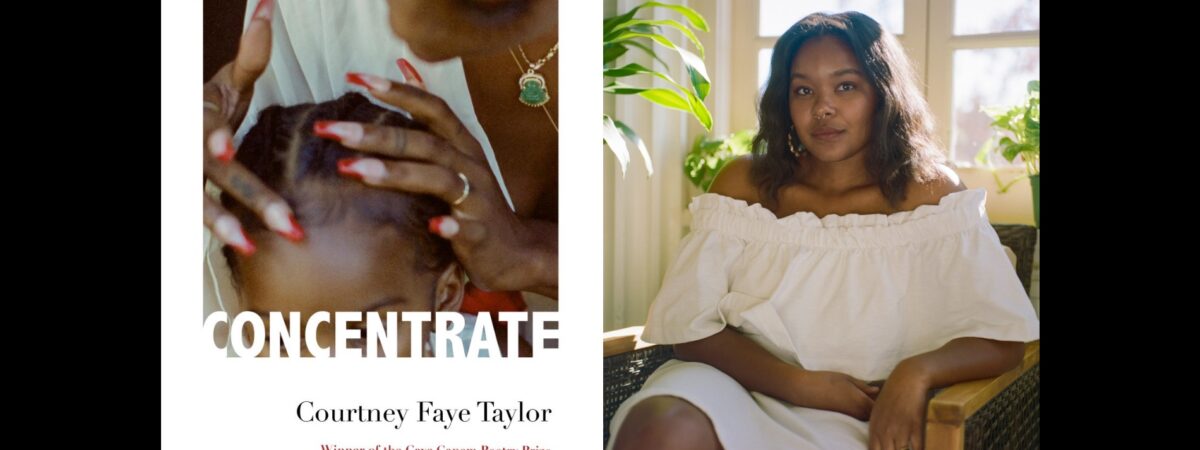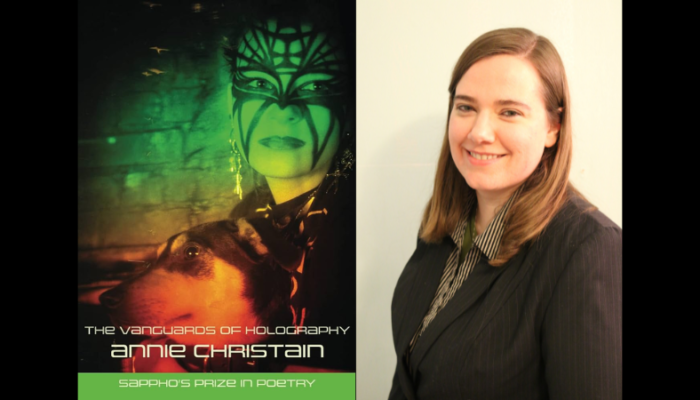When Courtney Faye Taylor begins her stunning debut collection, Concentrate—sat between her aunties thighs, getting her hair pressed—I am immediately transported back to my own childhood. Adolescence is a time of innocence and curiosity, as well as a lesson in contrasts: the sting of beauty upkeep and the confidence of a fresh hair-do, the validation of attention and the safety of invisibility. From the book’s opening section, Taylor makes it clear that Concentrate will stretch the expanse of what a poetry collection is allowed to do.
Visually, “The Talk” reflects a dialogue between an aunt and her niece, interrupted by newspaper clippings and collage. As the aunt grows frustrated with her niece’s inability to sit straight, hold her ear, turn left, and pay attention to the lessons she is dispensing as only an elder can, the poem’s tone fluctuates between tender and demanding, reflective and informative. When the niece gestures towards “that boy held in a hoodie with skittles” Aunt Notrie quickly claps “boys ain’t the only ones with chalk lines” (10); she offers a similar rebuttal when she offers that the gunshot “came out a woman. She of a color but / not ours” (11). Amidst the fussing and pressing, it is revealed that Aunt Notrie is referencing the killing of Latasha Harlins, a 15-year-old Black girl who was killed by Soon Ja Du, a Korean store clerk, in Los Angeles in 1991. Aunt Notrie’s story is meant as a lesson on being Black and woman, as she warns “[y]our Black ass’ll get offed wearing just about anyt—” (18).
Throughout this collection, Taylor considers her aunt’s caution, interrogating what it means to be surveilled as a Black girl navigating coming into her own identity. In a poem that replicates an online customer review, the speaker describes the “worst experiment of [her] life”—being watched through the cameras at her local beauty supply store, treated like a potential thief or safety threat. If entering the beauty supply store is an experiment, then the speaker is the specimen being examined without consent.Taylor’s diction highlights the invasiveness of being surveilled, particularly in community spaces. With a biting promise (“once the hood gets wind of your lil attitude this hair store gon go dark thru the windows forever, baby!”), she rates them a fitting “one star” (27).
In addition to the anger at being surveilled, this poem gestures towards the irony of a larger social context: while Black women are significant consumers of beauty products—with trips to the beauty supply store being a rite of passage in Black girlhood—very few of these stores are Black-owned. Despite their non-Black ownership, beauty supply stores are frequently opened in Black neighborhoods; in my own city, the running joke is that there is a beauty store on every corner. As Taylor illustrates, Black women often walk into these businesses with harmless intentions: looking for braiding hair, mink lashes, nail polish or other beautification items. For Black women, beauty rituals are both a point of pride and a tradition; many of us were raised with the notion that we don’t leave the house looking unkempt, or as Taylor puts it, “I go nowhere looking broke, I got jobS” (27). When non-black shop owners make the decision to treat Black women like criminals by monitoring their shopping time, that turns a pleasant shopping experience into a potentially dangerous excursion; a conflict with the wrong employee can turn a trip to buy braiding hair into an untimely and wrongful death. In her poem “Origin”, Taylor proclaims “I’m saying I’m a ghetto scared future beautiful / and Beauty / is what gets hardships, / mishandled.” (38) acknowledging the expectation and labor of beauty, while also highlighting the truth that beauty does not offer protection, and in many spaces, creates additional dangers for Black women.
In a different review poem, Taylor outlines a similar experience at a beauty supply store. There, the speaker browses wigs and satin caps while the male clerk literally follows her around the building, so close he’s sweeping the floor between her feet (91). Here, the surveillance is enacted physically, adding another layer of threat to the speaker. This store also receives one star, as the speaker advises potential customers to watch out for: “avoid this store, ladies. The man who owns it will reduce you everywhere.” (91) The idiomatic specificity of “the man” implies that the speaker’s discomfort is about more than just race- it is also about the dangers of patriarchy and toxic masculinity. Indeed, the impact of misogynoir is present throughout the collection, reminding the reader of the hardships the speaker experiences because she is both Black and woman.
At the center of these hardships is sexual violence. In a series of essays found in the section titled “Four Memorials”, Taylor writes about visiting Harlins’ hometown; when she gets there, she discovers that Harlins was being pursued by a camp counselor named Jerry who was “twice her age” , a man who Harlins may have spent her last night with (82). This relationship caused arguments in Harlin’s household, prompting comments such as “You think you grown? You think you in love”? (82). These comments highlight the adultification of Black girls; even in adolescence, Black girls are seen as “grown”, and are subsequently held to unreasonable adult standards and blamed for being put in risky situations.
However, Taylor pushes back against the misogynoir inherent in the belief that Black girls are fast or inviting the attention of older men. She argues that “ Rape is a room within every cishet man. It’s either locked or onerously doorless.” (83), and in doing so, shifts the blame that society places on Black girls and rightfully places it in the hands of potential perpetrators. In another critique, Taylor notes “ Everything I’ve ever done/ I keep in a jar marked innocent/ so that men can’t touch it” (86), suggesting that men lack the innocence needed to access such treasures. This line also highlights the reality that there is not a tangible method Black women and girls can use to guarantee they will be free of sexual violence. As it stands, 35% of Black women experience some form of contact sexual violence in their lifetime. However, this doesn’t mean that Taylor paints a hopeless picture. To the contrary, she delivers an indictment that feels like both prayer and prophecy:
Guilt will whoop the habitat
behind every Black man’s head and to his crimes
we’ll be ret to say, You tried to kill me but
you missed. Now who’s the master of what happened? (97)
Taylor’s declaration promises retribution for the harms Black women experience at the hand of Black men, and in a line that calls to mind Lucille Clifton’s poem “won’t you celebrate with me”, affirms Black women’s ability to thrive in spite of.
Taylor interweaves these episodes of being scrutinized–by family members, shop owners, people of color, and men of all races–with the story of Latasha Harlins’ life and death as portrayed through an assemblage of artifacts: community landmarks, posters describing missing women, “a mama’s cardstock anxieties pinned to phone poles, petting the air.” (16) These found and reproduced texts converse with and against newspaper headlines and clippings, store policy documents, and court transcriptions, including the ironic proclamation of Judge Joyce Karlin, who presided over Harlins’ murderer’s trial. She stated:
“..[T]o suggest that any sentence that this court might give results in the conclusion that young Black children don’t receive full protection of the law—I’m sorry, but that is dangerous… unjustified.” (12)
The hybridity of Taylor’s text makes it all the more evocative. Utilizing the starred review form helped the reader immediately contextualize the poor level of service the speaker receives at the various stores in her community. In the first two sections of text (Arizona and A thin obsidian life is heaving on a time limit you’ve set) Taylor takes photographs of missing women and splices the faces together —one bleeding into the next—outlining exactly how common it was for missing Black women to be mistaken for one another, their individuality and autonomy forgotten. In The phenomenon of withholding, poems rendered as timelines “detail a sermon of interactions” creating space for the reader to juxtapose and analyze various histories (49). Examining photographs of Harlin’s community and family members allows us to follow Taylor’s path to Harlin’s through her vision rather than our imagination.
Concentrate is a collection that made the whole of me feel seen. I have been the girl sitting between my aunties’ legs, being popped on the hand and lectured between swipes of the pressing comb. I am now the grown woman navigating racism, sexism, violence, and trying desperately to stay alive. In another life, Latasha Harlins could have been my cousin, or best friend. Personal connections aside, I remain in awe of how careful Taylor was in tackling such heavily nuanced themes; her ability to honor truth, history, and ethics moves me every time I revisit this collection.Concentrate is at once expansive and intimate, global and individual. This collection is a must read for anyone considering racial tension, coming of age, and perceptions of safety—for anyone navigating the politics of being Black, woman, and autonomous.



